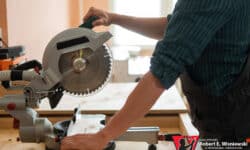Every year, far too many people are injured or killed in the workplace. In 2018, the National Safety Council (NSC) estimated that work injuries cost the workforce $170.8 billion. What’s more, the human cost of a sudden and tragic death in a fatal work accident—and the havoc wreaked upon grieving loved ones—is impossible to calculate.
Consistently among the top causes of workplace injuries is slip and fall accidents. Thankfully, slip and fall can easily be prevented by wearing the proper footwear.
Kurt Beschorner, Associate Professor of bioengineering at The University of Pittsburgh and a researcher at the Human Movement & Balance Laboratory, worked with others to conduct a study predicting the risk of slip and fall injury by looking at the tread of a worker’s shoe.
Partnering with the National Occupational Research Agenda (NORA) Traumatic Injury Prevention Council, the team examined the impact that wearing worn shoes has on the risk of slipping, as well as creating better signage for safety purposes.
According to Beschorner, “[o]ur research focuses on understanding the underlying causes of slippery shoes, and we have been working to identify the tread thresholds where shoes become unsafe.”
Furthermore, Beschorner discussed that while shoes that are designed to be slip-resistant work thanks to the inclusion of “train channels that help drain fluid,” these “channels disappear and become ineffective” the more the shoes are worn.
As the channels disappear, the shoes can create a situation similar to how car tires hydroplane on a road when it rains. Of course, the risk of a worker slipping depends on how badly their shoe treads have worn.
From the data collected, the team developed a test that uses a battery to help workers have a better idea of when it’s time to replace their shoes.
According to Beschorner, workers use a AA battery as a unit of measurement in the worn regions of a slip-resistant shoe. This is basically the same concept as checking the treads on your tires with a penny.
When a worn patch on your slip-resistant shoes becomes larger than the base of an AA battery, your shoes are no longer as safe as they can be and should be replaced.
The larger the worn patches on a shoe, the more rapidly the slip-resistance of the shoe declines.
So why batteries?
The team considered a variety of different measuring tools. However, things like pens and currency aren’t globally universal and vary by brand. The same isn’t true of batteries.
Likewise, shoes will wear at different rates depending on the wearer (specifically, their walking style), the terrain they work on and the shoe itself. For this reason, Beschorner recommends frequently inspecting your footwear and replacing worn ones before large patches appear.
Workers’ compensation for a slip and fall at work
Slip and fall injuries can range from very minor to severe to deadly. The most common injuries that occur when a worker slips, trips or falls include:
- Cuts, scrapes and bruises
- Back and spinal cord injuries
- Hip fractures
- Muscle sprains and strains (soft tissue injuries)
- Shoulder injuries
- Traumatic brain injury (TBI)
Where do slip and falls at work happen?
Regardless of where you work—whether you spend your time on a construction site or behind a desk—there’s always a chance that you could trip over a misplaced item or an unseen melted ice cube on a slick surface.
Statistically, though, the occupations with the highest rates of slip and fall accidents include:
- Carpenters
- Construction workers
- Government employees
- Healthcare professionals
- Landscape workers
- Maintenance workers, cleaners and janitors
- Manufacturing workers
- Miners
- Restaurant workers
- Roofers
- Service and retail employees
- Teachers
- Tree trimmers
- Truck drivers
- Warehousing laborers
Common causes of workplace slip, trip and falls
Slip and fall accidents are preventable if proper attention is paid to the worksite and safety is prioritized. The most common causes of slip and falls at work include:
- Clutter and debris
- Inadequate caution signage
- Poor lighting
- Potholes or cracks
- Uneven or broken flooring/stairs
- Unexpected drops
- Wet floors
What to do after a slip and fall accident on the job
In Arizona, workers who are injured on the job have 1 year in which to file a workers’ compensation claim. However, even though you have a year to file a claim doesn’t mean that you should wait that long. If you’re involved in an accident at work, there are 4 immediate and urgent steps you’ll need to take to start the compensation process.
1. Get medical attention
Regardless of the severity of your injury, your first step should be to seek medical attention. Depending on how bad you’re hurt, you should go to the emergency room, an urgent care or make an appointment with your general practitioner. Seeking medical attention even for simple accidents may seem like overkill, but (especially when your head is involved) injuries may not always be obvious at first.
2. Notify your supervisor/employer
After you’ve been treated by a doctor, you’ll need to let your manager, supervisor and/or employer know that you’ve been injured. If you don’t promptly notify your employer, you could see a reduction—or denial—of your workers’ comp benefits. Even if you told your employer/supervisor of your injury before seeking medical attention, generally you’ll need to submit a written account of the injury after you’ve gotten medical attention.
3. File your claim
When you speak with your doctor about your injury, ask them to evaluate you in terms of a workers’ compensation claim by filing a claim with the Industrial Commission of Arizona. There’s a chance that your employer won’t file for you, so it’ll be your responsibility to file your own claim as soon as possible.
4. Consult an attorney
In order to ensure that you get all the compensation you’re entitled to, we advise all injured workers to speak with an experienced Arizona workers’ compensation attorney. Moreover, before you agree to any claims benefits or if your claim gets denied, you should consult an attorney as well.


